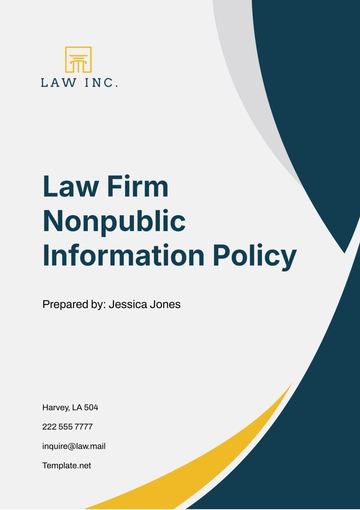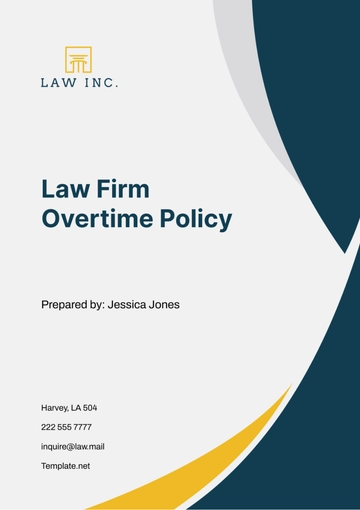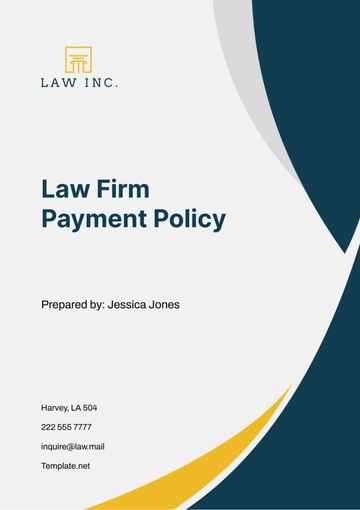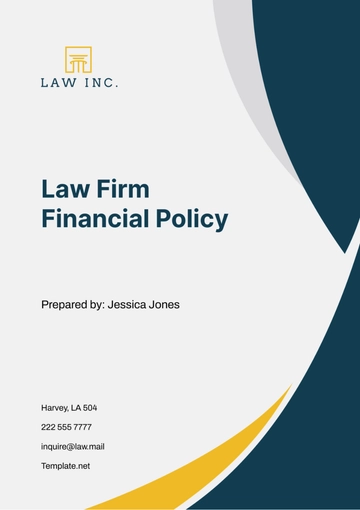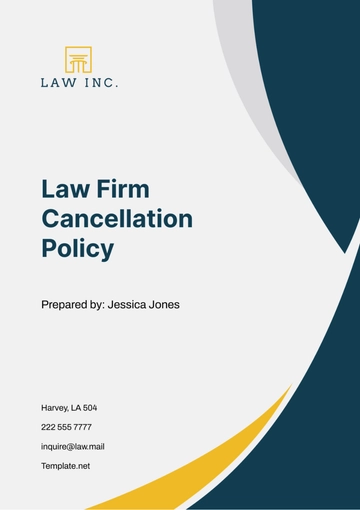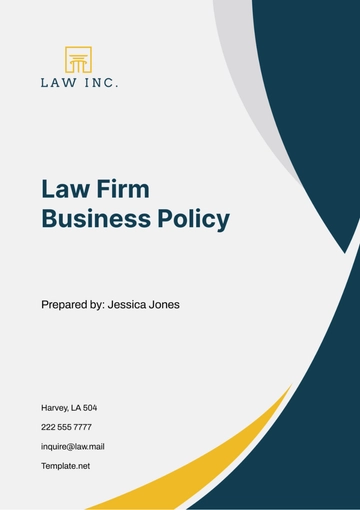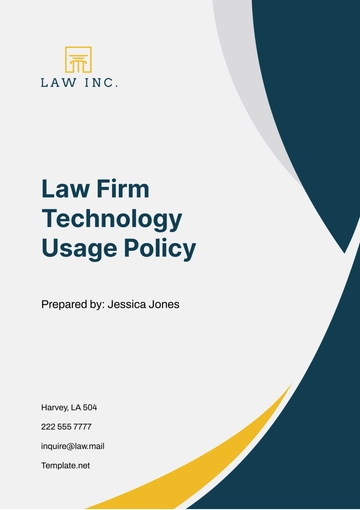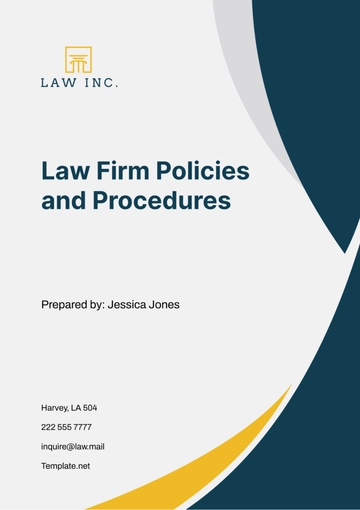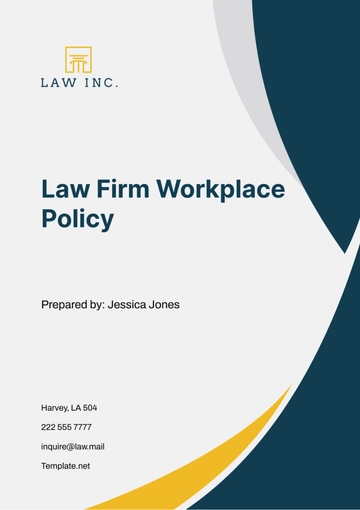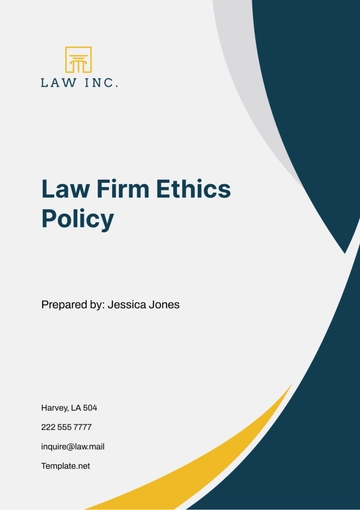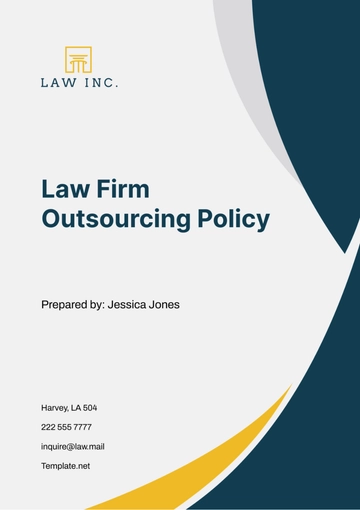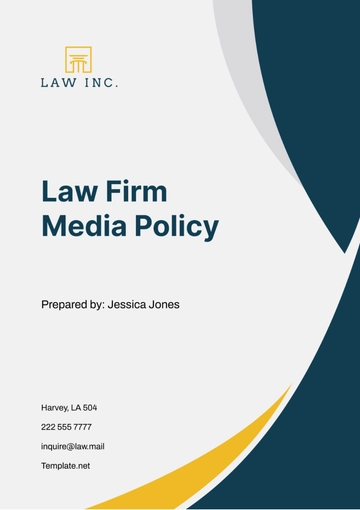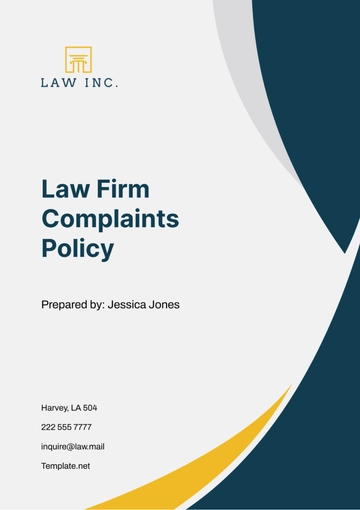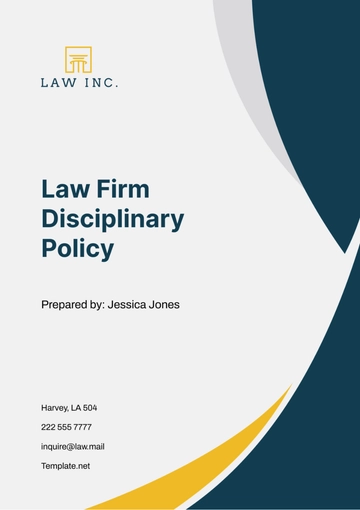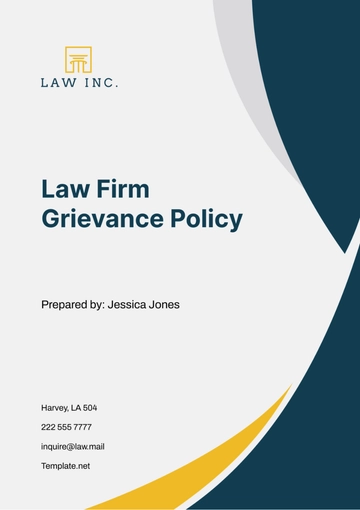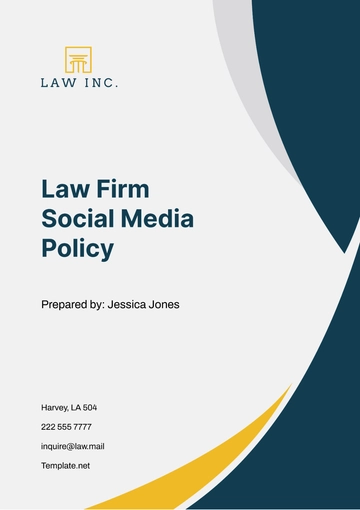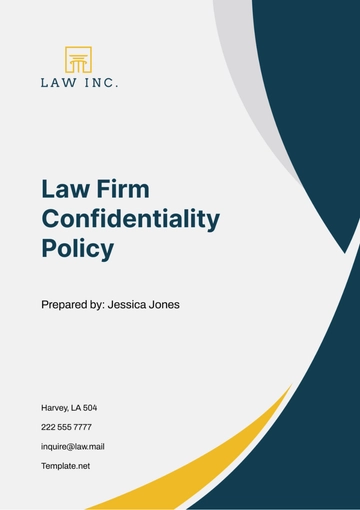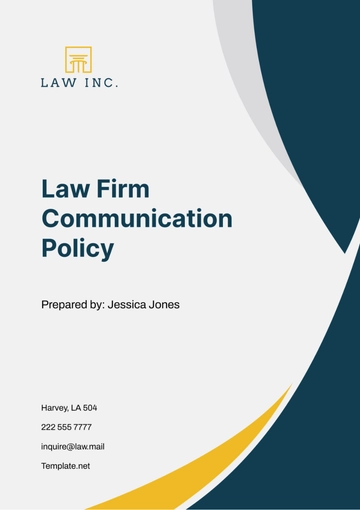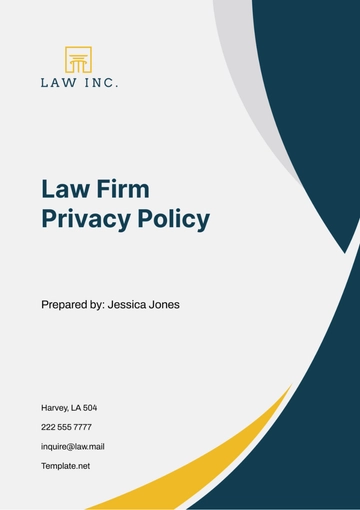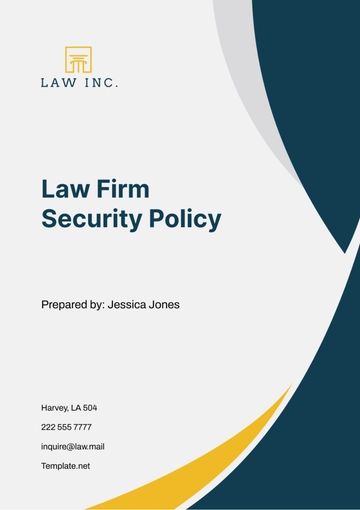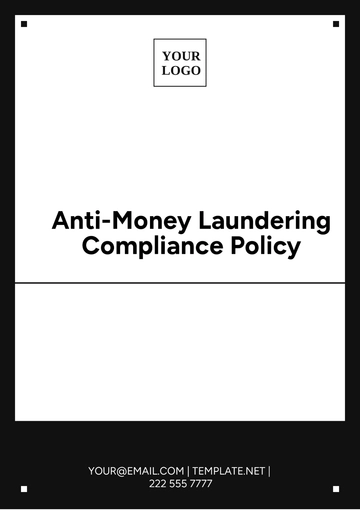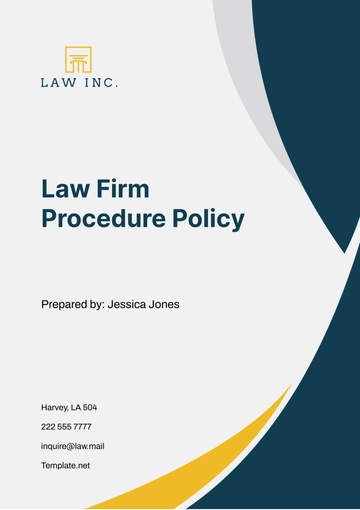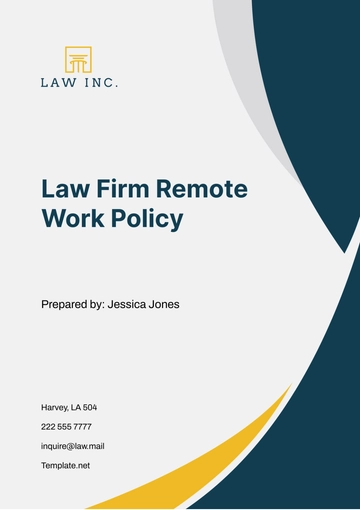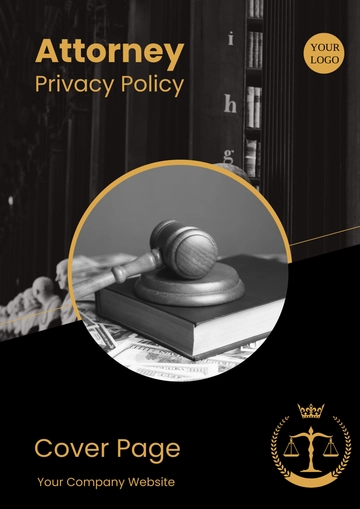Free Law Firm Communication Policy
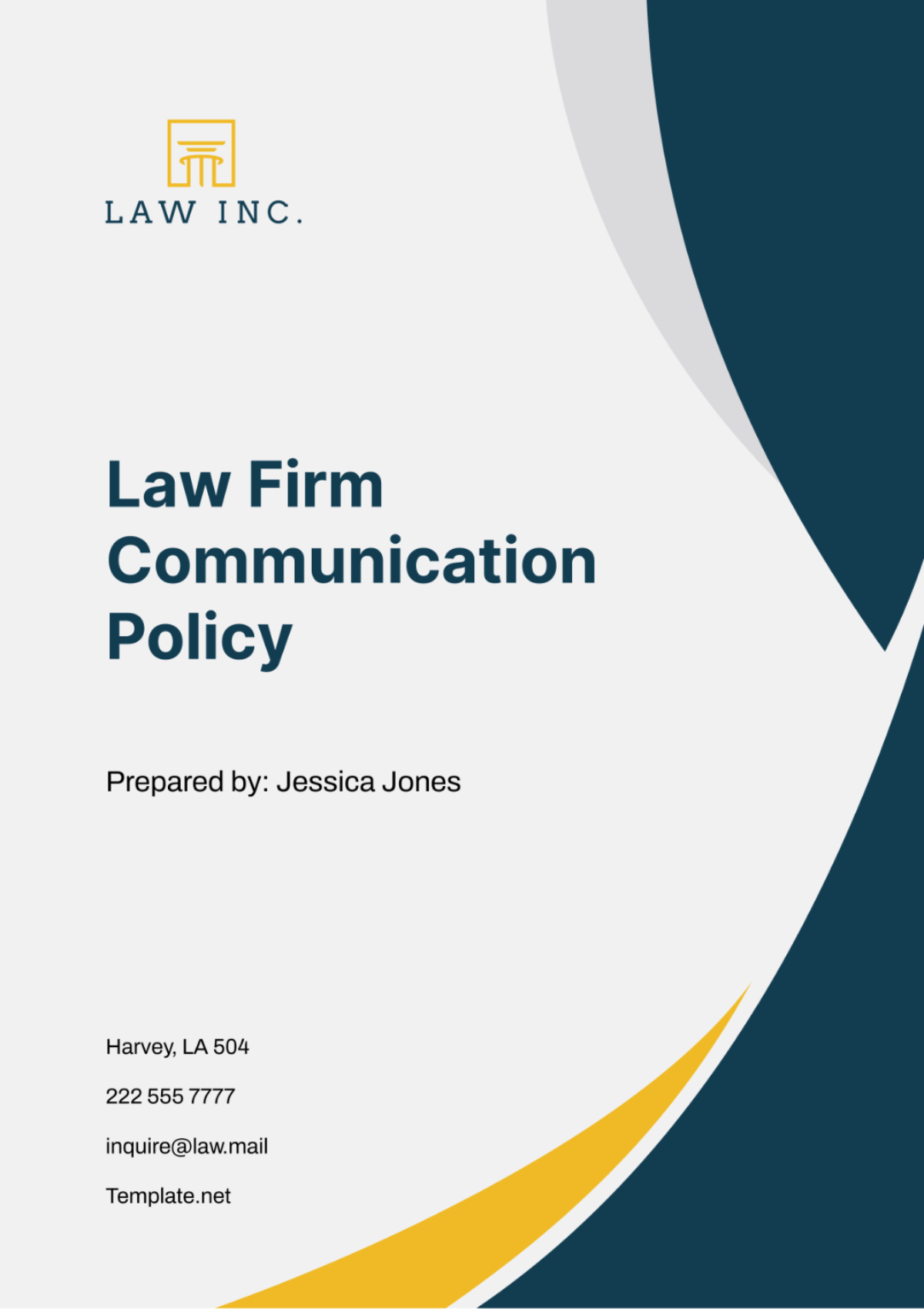
I. Introduction
A. Purpose
The purpose of this Law Firm Communication Policy is to establish guidelines and procedures for effective communication within [Your Company Name] and with external parties. Effective communication is essential for maintaining client relationships, ensuring confidentiality, and upholding professional standards within the legal profession.
This policy aims to promote clear, timely, and professional communication practices among all employees, contractors, and partners of [Your Company Name], contributing to the firm's reputation for excellence and reliability in client service.
B. Scope
This policy applies to all individuals affiliated with [Your Company Name], including attorneys, paralegals, administrative staff, contractors, and consultants, who engage in communication activities on behalf of the firm.
It encompasses all forms of communication, including but not limited to verbal, written, electronic, and in-person interactions, whether conducted internally within the firm or externally with clients, opposing counsel, courts, regulatory agencies, and other third parties.
II. General Communication Guidelines
A. Professionalism and Ethical Conduct
All communication conducted by employees of [Your Company Name] must adhere to the highest standards of professionalism, integrity, and ethical conduct. This includes maintaining confidentiality, avoiding conflicts of interest, and upholding the attorney-client privilege.
Employees should be mindful of their tone, language, and demeanor in all communication interactions, ensuring that they reflect positively on the firm and its values.
B. Clear and Concise Communication
Communication within [Your Company Name] should be clear, concise, and free of unnecessary technical jargon or legalese. Complex legal concepts should be explained in a manner that is understandable to clients and non-legal professionals.
Written communication, including emails, memoranda, letters, and legal documents, should be drafted with attention to detail, accuracy, and clarity, to minimize the risk of misinterpretation or misunderstanding.
C. Timeliness and Responsiveness
Employees are expected to respond promptly to all communication received from clients, colleagues, and external parties, within a reasonable timeframe. Urgent matters should be prioritized and addressed without delay, to ensure that client needs are met and deadlines are fulfilled.
In cases where a response cannot be provided immediately, employees should acknowledge receipt of the communication and provide an estimated timeline for follow-up or resolution, to manage expectations and maintain transparency.
D. Compliance with Legal and Regulatory Requirements
All communication activities undertaken by employees of [Your Company Name] must comply with applicable laws, regulations, and professional standards governing the legal profession. This includes but is not limited to rules of professional conduct, data privacy laws, and regulations governing the use of electronic communication.
Employees should exercise caution when discussing confidential client matters or sensitive legal issues in communication channels that may not be secure, such as email or social media, to protect client confidentiality and avoid potential breaches of privacy.
III. Modes of Communication
A. Email Communication
Email remains a primary mode of communication within [Your Company Name] for non-urgent matters. It is suitable for internal correspondence among colleagues, communication with clients, and interaction with external parties such as opposing counsel, courts, and regulatory agencies.
Guidelines for Email Communication:
a. Subject Line: Employees should use clear and descriptive subject lines to summarize the content of the email and facilitate efficient organization and retrieval of messages.
b. Recipients: Emails should be addressed only to individuals who have a legitimate need to receive the information. Use of the "Reply All" function should be judicious to avoid unnecessary clutter in inboxes.
c. Confidentiality: Employees must exercise caution when transmitting sensitive or confidential information via email. When necessary, encryption or secure file transfer protocols should be utilized to safeguard data.
d. Professionalism: All emails sent on behalf of [Your Company Name] should maintain a professional tone and adhere to established formatting and branding guidelines. Proofreading for grammatical errors and typos is essential to uphold the firm's reputation for excellence.
Email Etiquette:
Etiquette Point
Description
Use of Greetings
Begin emails with a courteous greeting, such as "Dear [Recipient's Name]" or "Hello [Recipient]."
Clarity and Brevity
Keep emails concise and to the point, avoiding unnecessary verbosity or tangential discussions.
Response Time
Aim to respond to emails within [24 hours] during regular business hours, or sooner for urgent matters.
Signatures
Include a professional email signature with contact information and [Your Company Name] branding.
B. Phone Communication
Phone calls serve as a direct and immediate means of communication, suitable for urgent matters, confidential discussions, or situations where real-time dialogue is required.
Guidelines for Phone Communication:
a. Identification: When making or receiving phone calls on behalf of [Your Company Name], employees should identify themselves and the firm to ensure clarity and professionalism.
b. Active Listening: Employees should practice active listening during phone conversations, allowing the speaker to fully express their concerns or questions before providing a response.
c. Message Taking: When receiving phone messages for colleagues, employees should accurately record the caller's name, contact information, message details, and the time of the call for follow-up purposes.
d. Confidentiality: Care should be taken to ensure that sensitive information is not inadvertently disclosed during phone conversations, especially when discussing client matters or legal strategies.
Phone Etiquette:
Etiquette Point
Description
Professional Greeting
Answer calls with a professional greeting, such as "[Your Company Name], [Employee's Name] speaking."
Tone of Voice
Maintain a calm and professional tone of voice, even in challenging or stressful situations.
Call Transfer
When transferring calls, inform the caller of the transfer and provide the name of the recipient.
Follow-Up
After phone conversations, follow up with written confirmation of any agreements or action items.
C. In-Person Communication
Face-to-face meetings offer the opportunity for personal interaction and effective communication, particularly for complex discussions, negotiations, or sensitive matters.
Guidelines for In-Person Communication:
a. Scheduling: Meetings should be scheduled in advance whenever possible to ensure that all relevant parties can participate and prepare accordingly.
b. Agenda Setting: An agenda should be established for each meeting to outline topics for discussion, allocate time for each item, and maintain focus and productivity.
c. Active Participation: Participants should actively engage in discussions, listen attentively to others' perspectives, and contribute constructively to the dialogue.
d. Confidentiality: Confidential information shared during in-person meetings should be treated with the utmost discretion and not disclosed to unauthorized individuals.
Meeting Etiquette:
Etiquette Point
Description
Punctuality
Arrive on time for meetings and respect the scheduled duration to minimize disruptions and delays.
Respectful Behavior
Maintain a respectful and courteous demeanor towards all meeting participants, regardless of rank.
Technology Use
Minimize distractions by refraining from using electronic devices unless necessary for the meeting.
Follow-Up Actions
After meetings, distribute minutes or summaries outlining key decisions, action items, and deadlines.
IV. Use of Technology and Social Media
A. Authorized Technology Platforms
[Your Company Name] provides employees with access to authorized technology platforms to facilitate communication, collaboration, and productivity. These platforms may include but are not limited to:
a. Email and Calendar Systems
b. Document Management and Sharing Tools
c. Video Conferencing Software
d. Case Management Systems
e. Secure File Transfer Services
Employees are expected to utilize these platforms responsibly and in accordance with [Your Company Name]'s policies and procedures, to safeguard sensitive information and maintain data security.
B. Social Media Guidelines
[Your Company Name] recognizes the value of social media as a tool for professional networking, marketing, and thought leadership. However, employees engaging in social media activities on behalf of the firm must adhere to the following guidelines:
a. Professionalism: Employees should maintain a professional demeanor and represent [Your Company Name] in a positive light when posting or commenting on social media platforms.
b. Compliance: All social media activities must comply with applicable laws, regulations, and professional standards, including rules of professional conduct and client confidentiality requirements.
c. Discretion: Employees should exercise discretion when discussing firm-related matters or sharing content on social media, avoiding the disclosure of confidential information or the expression of personal opinions that may reflect negatively on the firm.
d. Separation of Personal and Professional Accounts: Employees are encouraged to maintain separate personal and professional social media accounts to prevent confusion and minimize the risk of inappropriate or unauthorized posts.
[Your Company Name] may provide training and guidance to employees on best practices for leveraging social media effectively and responsibly to promote the firm's brand and reputation.
V. Records Management and Retention
A. Documentation of Communication
Employees of [Your Company Name] are required to maintain accurate records of all communication related to client matters, firm business, and other relevant interactions. This includes but is not limited to:
a. Emails: Copies of all emails sent and received pertaining to client communications, case updates, and internal discussions.
b. Phone Logs: Records of phone calls made and received, including caller information, timestamps, and summaries of discussions.
c. Meeting Minutes: Notes or summaries of in-person meetings, teleconferences, and video conferences documenting key decisions, action items, and follow-up tasks.
d. Written Correspondence: Copies of letters, memoranda, faxes, and other written communications exchanged with clients, opposing counsel, courts, and third parties.
Documentation should be maintained in a secure and organized manner, either electronically or in hard copy, to ensure accessibility and ease of retrieval when needed.
B. Retention Period
Communication records should be retained for the period specified in [Your Company Name]'s records retention schedule, which is designed to comply with legal and regulatory requirements and to meet business needs.
The retention period for communication records may vary depending on factors such as the nature of the matter, the applicable statute of limitations, and any specific client requirements or contractual obligations.
At the end of the retention period, communication records should be securely disposed of in accordance with [Your Company Name]'s records management policies and procedures. This may involve shredding physical documents or permanently deleting electronic files to prevent unauthorized access or disclosure of sensitive information.
VI. Enforcement
A. Compliance Monitoring
[Your Company Name] is committed to ensuring compliance with the Law Firm Communication Policy to maintain the integrity of communication practices within the firm and uphold professional standards.
Compliance monitoring will be conducted periodically by the Compliance Officer, department heads, or designated personnel to assess adherence to the policy's guidelines and procedures.
Monitoring activities may include:
a. Review of Communication Records: Examination of email correspondence, phone logs, meeting minutes, and other communication records to identify any instances of non-compliance or policy violations.
b. Employee Interviews: Conducting interviews or surveys with employees to gather feedback on their understanding of the communication policy, challenges encountered, and suggestions for improvement.
c. Observation of Practices: Observation of communication practices in real-time, such as phone calls, meetings, or email exchanges, to assess adherence to established guidelines and identify areas for intervention or training.
d. Compliance Audits: Conducting formal compliance audits or assessments to evaluate the effectiveness of the communication policy in achieving its objectives and identifying opportunities for enhancement.
The results of compliance monitoring activities will be documented and reported to [Your Company Name]'s management team for review and action as necessary.
B. Reporting Violations
Employees who become aware of violations of the Law Firm Communication Policy are encouraged to report them promptly to their supervisor, department head, Compliance Officer, or the designated reporting mechanism established by [Your Company Name].
Reports of policy violations should include details of the incident, such as the nature of the violation, individuals involved, and any supporting evidence or documentation.
Employees who report violations in good faith will be protected from retaliation and assured confidentiality to the extent permitted by law and [Your Company Name]'s policies.
Upon receipt of a report, [Your Company Name] will conduct a thorough investigation into the alleged violation, following established procedures for handling complaints and grievances.
C. Corrective Action
In the event that a violation of the communication policy is substantiated through investigation, appropriate corrective action will be taken in accordance with [Your Company Name]'s disciplinary policies and procedures.
Corrective actions may include:
a. Verbal Warning: Informal counseling or verbal warning issued to the employee to address minor infractions and provide guidance on compliance expectations.
b. Written Warning: Formal written documentation of the policy violation and consequences issued to the employee, highlighting the importance of adherence to policy guidelines.
c. Probationary Period: Placement of the employee on probation with specific performance improvement goals and monitoring requirements to ensure compliance going forward.
d. Suspension: Temporary suspension from work without pay for serious or repeated violations of the communication policy, pending further investigation or resolution.
e. Termination: Termination of employment in cases of egregious or repeated violations of the policy that undermine the firm's reputation, client trust, or legal obligations.
Corrective actions will be administered consistently and in accordance with [Your Company Name]'s policies, with due consideration given to the severity of the violation, the employee's disciplinary history, and mitigating factors.
D. Employee Education and Training
[Your Company Name] will provide ongoing education and training to employees on the Law Firm Communication Policy to enhance awareness, understanding, and compliance.
Training initiatives may include:
a. New Employee Orientation: Incorporating communication policy training into the onboarding process for new hires to familiarize them with policy guidelines and expectations from the outset.
b. Annual Refresher Training: Conducting regular refresher sessions or online modules to reinforce key concepts, address common challenges, and provide updates on policy revisions.
c. Role-Specific Training: Tailoring training programs to address the unique communication needs and challenges faced by different roles within the firm, such as attorneys, paralegals, and administrative staff.
d. Case Studies and Scenarios: Using real-life case studies or scenarios to illustrate the importance of effective communication, ethical decision-making, and the consequences of policy violations.
Participation in training sessions will be tracked and recorded to ensure that all employees receive the necessary education and support to fulfill their communication responsibilities effectively.
VIII. Policy Review
A. Regular Review
This Law Firm Communication Policy will undergo periodic review and assessment by [Your Company Name]'s management team to ensure its effectiveness, relevance, and compliance with evolving legal and regulatory requirements.
The policy review process will include a comprehensive examination of communication practices, feedback from employees and stakeholders, and analysis of any emerging trends or developments in communication technology.
The frequency of policy review will be determined by [Your Company Name]'s management team, with consideration given to factors such as changes in industry standards, significant legal developments, or feedback from internal or external audits.
B. Communication of Changes
Any updates, modifications, or revisions to this policy will be communicated to all employees of [Your Company Name] through internal communication channels, such as email, intranet postings, or staff meetings.
Employees will be provided with training and guidance on the updated policies and procedures to ensure understanding and compliance.
[Your Company Name]'s Human Resources department will maintain records of policy acknowledgments and employee training to demonstrate compliance with the revised communication policy.
- 100% Customizable, free editor
- Access 1 Million+ Templates, photo’s & graphics
- Download or share as a template
- Click and replace photos, graphics, text, backgrounds
- Resize, crop, AI write & more
- Access advanced editor
Enhance your law firm's communication standards with Template.net's Law Firm Communication Policy Template. This comprehensive document is fully editable and customizable, ensuring it aligns perfectly with your firm's unique requirements. Crafted with precision, it's easily tailored to uphold professionalism and efficiency in all internal and external communications. Editable in our Ai Editor Tool for seamless customization.
You may also like
- HR Policy
- Restaurant Policy
- Company Policy
- Accounting Policies and Procedures
- Website Policy
- Privacy Policy
- Safety Policy
- School Policy
- IT and Software Policy
- Law Firm Policy
- Construction Policy
- Interior Design Policy
- Travel Agency Policy
- Education Academic Policy
- Security Policy
- Real Estate Policy
- Expense Policy
- Software Policy
